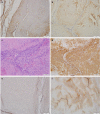Does BMP2 play a role in the pathogenesis of equine degenerative suspensory ligament desmitis?
- PMID: 30227887
- PMCID: PMC6145121
- DOI: 10.1186/s13104-018-3776-9
Does BMP2 play a role in the pathogenesis of equine degenerative suspensory ligament desmitis?
Abstract
Objective: Horses afflicted with degenerative suspensory ligament desmitis (DSLD) suffer from progressive leg pain and lameness without history of trauma. DSLD is a systemic disorder caused by abnormal accumulation of proteoglycans in many connective tissues. One proteoglycan found in higher quantities in DSLD is decorin. The accumulated decorin has an abnormally glycosylated glycosaminoglycan chain in DSLD. In addition to acellular accumulations of proteoglycans foci of active fibroblasts/tenoblasts were observed in some tendons and suspensory ligaments (SLs) from DSLD cases We have hypothesized that this represents an early event in DSLD and that production of chondrogenic growth factors, such as BMP2, and/or enzyme participating in glycosylation of glycosaminoglycans is a major factor in initiation and progression of DSLD.
Results: Using immunohistochemistry we have identified BMP2 in these cellular foci, indicating association with proteoglycan production, but not in other cells in the tendon and SLs. In contrast, very little staining for TGFβ and dermatan sulfate epimerase, an enzyme involved in glycosylation of glycosaminoglycan chains, was observed in these foci and other cells in both control and DSLD-affected tendons and SLs. Our data support our hypothesis that chondrogenic growth factors may be responsible, at least in part for progression of DSLD in horses.
Keywords: BMP2; Equine degenerative suspensory ligament desmitis; Proteoglycans.
Figures


References
-
- Mero JL, Pool R (ed). Twenty cases of degenerative suspensory ligament desmitis in Peruvian Paso horses. In: Proceedings, annual convention of AAEP 2002; Orlando.
-
- Young JH. Degenerative suspensory ligament desmitis. Hoofcare Lameness. 1993;6:19.
-
- Halper J, Khan A, Mueller POE. Degenerative suspensory ligament desmitis—a new reality. Pak Vet J. 2011;31(1):1–8.
-
- Kim B, Yoon JH, Zhang J, Eric Mueller PO, Halper J. Glycan profiling of a defect in decorin glycosylation in equine systemic proteoglycan accumulation, a potential model of progeroid form of Ehlers-Danlos syndrome. Arch Biochem Biophys. 2010;501(2):221–231. doi: 10.1016/j.abb.2010.06.017. - DOI - PubMed
MeSH terms
Substances
LinkOut - more resources
Full Text Sources
Other Literature Sources

